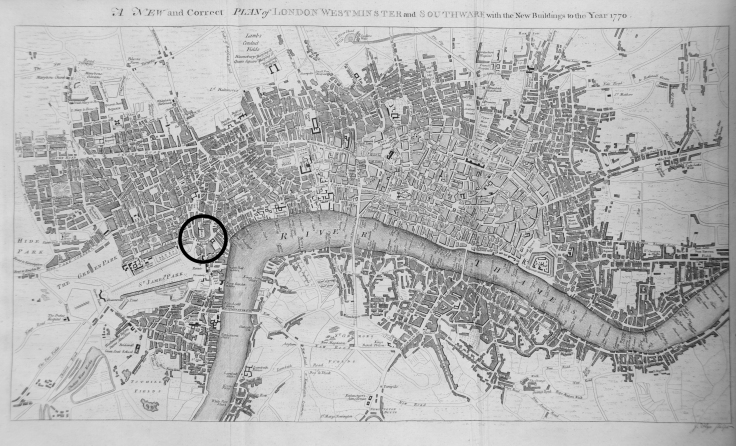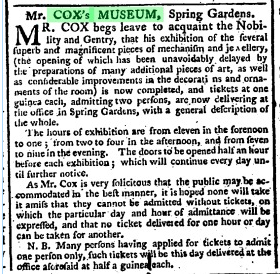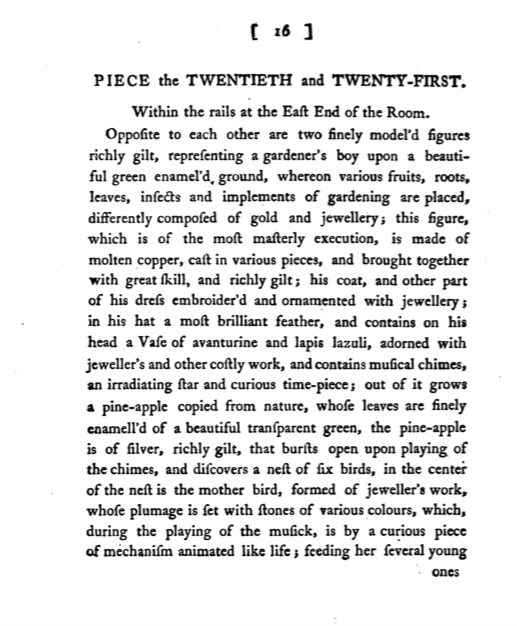In 1772, James Cox opened his fantastic museum filled with his beautiful and intricate inventions including automata, clocks, and jewelry.
In Letter XIX in Volume I of Frances Burney’s Evelina, Evelina called James Cox’s Museum “very astonishing, and very superb” (Burney 77). Opening during 1772, James Cox’s Museum was located in Spring Gardens, Charing Cross, London. On the map below you can see that it is near Scotland Yard.


Born in 1723, James Cox was a clockmaker, jeweler, and entrepreneur who created lavish pieces of automata. Cox became famous after impressing the Chinese Emperor Chi’en Lung with his automata. His museum featured twenty-three automata originally created for Chinese trade. Admission for Cox’s Museum was priced at a very steep ten shillings and six pence; this price included a catalogue with descriptions of the exhibits. The ad from the February 22, 1772 London Evening Post confirms that Cox was indeed catering to the “Nobility and Gentry.” The museum closed around 1775 after Cox’s exhibits went up for lottery.

The characters of Evelina have various opinions on Cox’s Museum. Their opinions of Cox’s wonderful inventions reveal many things about their class and characteristics. Madame Duval, a former barmaid turned want-to-be French socialite who lives for the gaudiest of expenses, finds the museum to be the “grandest, prettiest, finest sight that ever [she saw], in England” and that if anyone did not like it, they “like nothing” (Burney 78). Madam Duval’s quote shows how her opinions always fit in with what she believes the upper-class would conform to.
In contrast, Evelina, a well-educated member of the gentry, says the museum “afforded [her] little pleasure, for it is a mere show” (Burney 77). Because Evelina was not raised around such fancy things she sees the show as being excessive and does not see the point in it. This goes against Madame Duval’s opinion and shows Evelina as being one who sees more than just gold and fanciful things. This shows the educated Evelina’s tendency to look for a deeper meaning, unlike Madame Duval’s habit of only looking at the pretty surface of things.
Like Evelina, Captain Mirvan believes that Cox’s Museum is excessive, but his thoughts showcase his distaste for the French caused by his time in the war. Captain Mirvan says, “I suppose this may be in your French taste? It’s like enough for it’s all kickshaw work. But, pr’ythee, friend, will you tell me the use of all this? For I’m not enough of a conjurer to find it out” (Burney 78). Captain Mirvan’s opinion is parallel to Evelina’s because he cannot quite see the point of the display aside from being excessive and fancy, quite like Madame Duval. His harsh opinion and insults of the French culture mark him as a crude man who is conditioned to life in the war. Also, his class is not quite as high as Madame Duval.
Despite being of a high class, Lord Orville’s opinion of Cox’s Museum parallels that of Evelina’s as well. Orville says, “its purport is so frivolous, so very remote from all aim at instruction or utility, that the sight of so fine a shew, only leaves a regret on the mind, that so much work, and so much ingenuity, should not be better bestowed” (Burney 111). Orville’s opinion sets him apart from the others of his high social class, marking him as the perfect match for Evelina. Like Evelina, he searches for a deeper meaning and wishes Cox would use his intelligence for something more useful. The photo below is a description from the catalogue of a piece that Evelina describes and that Madame Duval calls “prettier than all the rest! I declare, in all my travels, I never see nothing eleganter” (Burney 78).

Numerous inventions of James Cox are still able to be seen. For example, the Silver Swan resides at the Bowes Museum in England and the Golden Peacock is at the Ermitage Museum in Russia. The links will showcase both of the invention so you can feel like you are taking in the sights with Evelina and her company. Are you like Evelina and do you not quite understand the hype around the automata, or, like Madame Duval, do you think it is the finest sight?
Written by Rhiannon Wineland, Washington and Jefferson Class of 2020
Works Cited
Burney, Frances. Evelina. Oxford University Press, New York, 2002.
Ferguson, Stephen. “Mr. Cox’s Perpetual Motion • A Mechanical and Philosophical Time Piece • So Capital a Performance. “ Rare Books @ Princeton, May 24, 2008.
Le Corbeiller, Clare. “James Cox and His Curious Toys. The Metropolitan Museum of Art Bulletin. Jun., 1960.
Leopold, J.H. Vincent, Clare. “James Cox (ca. 1723–1800): Goldsmith and Entrepreneur.” , Metropolitan Museum of Art, November 2008.
London Evening Post. February 25, 1772